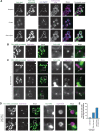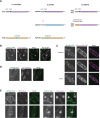ER-localized phosphatidylethanolamine synthase plays a conserved role in lipid droplet formation
- PMID: 34818062
- PMCID: PMC8886813
- DOI: 10.1091/mbc.E21-11-0558-T
ER-localized phosphatidylethanolamine synthase plays a conserved role in lipid droplet formation
Abstract
The asymmetric distribution of phospholipids in membranes is a fundamental principle of cellular compartmentalization and organization. Phosphatidylethanolamine (PE), a nonbilayer phospholipid that contributes to organelle shape and function, is synthesized at several subcellular localizations via semiredundant pathways. Previously, we demonstrated in budding yeast that the PE synthase Psd1, which primarily operates on the mitochondrial inner membrane, is additionally targeted to the ER. While ER-localized Psd1 is required to support cellular growth in the absence of redundant pathways, its physiological function is unclear. We now demonstrate that ER-localized Psd1 sublocalizes on the ER to lipid droplet (LD) attachment sites and show it is specifically required for normal LD formation. We also find that the role of phosphatidylserine decarboxylase (PSD) enzymes in LD formation is conserved in other organisms. Thus we have identified PSD enzymes as novel regulators of LDs and demonstrate that both mitochondria and LDs in yeast are organized and shaped by the spatial positioning of a single PE synthesis enzyme.
Figures







Similar articles
-
Phosphatidylserine flux into mitochondria unveiled by organelle-targeted Escherichia coli phosphatidylserine synthase PssA.FEBS J. 2021 May;288(10):3285-3299. doi: 10.1111/febs.15657. Epub 2020 Dec 30. FEBS J. 2021. PMID: 33283454
-
Lipid Homeostasis Is Maintained by Dual Targeting of the Mitochondrial PE Biosynthesis Enzyme to the ER.Dev Cell. 2018 Jan 22;44(2):261-270.e6. doi: 10.1016/j.devcel.2017.11.023. Epub 2017 Dec 28. Dev Cell. 2018. PMID: 29290583 Free PMC article.
-
MICOS and phospholipid transfer by Ups2-Mdm35 organize membrane lipid synthesis in mitochondria.J Cell Biol. 2016 Jun 6;213(5):525-34. doi: 10.1083/jcb.201602007. Epub 2016 May 30. J Cell Biol. 2016. PMID: 27241913 Free PMC article.
-
Cell biology, physiology and enzymology of phosphatidylserine decarboxylase.Biochim Biophys Acta Mol Cell Biol Lipids. 2017 Jan;1862(1):25-38. doi: 10.1016/j.bbalip.2016.09.007. Epub 2016 Sep 17. Biochim Biophys Acta Mol Cell Biol Lipids. 2017. PMID: 27650064 Review.
-
Phospholipid synthesis and transport in mammalian cells.Traffic. 2015 Jan;16(1):1-18. doi: 10.1111/tra.12230. Epub 2014 Oct 15. Traffic. 2015. PMID: 25243850 Review.
Cited by
-
An intermembrane space protein facilitates completion of mitochondrial division in yeast.bioRxiv [Preprint]. 2023 Mar 31:2023.03.31.535139. doi: 10.1101/2023.03.31.535139. bioRxiv. 2023. Update in: J Cell Biol. 2023 Oct 2;222(10):e202303147. doi: 10.1083/jcb.202303147. PMID: 37034761 Free PMC article. Updated. Preprint.
-
Fundamental roles for inter-organelle communication in aging.Biochem Soc Trans. 2022 Oct 31;50(5):1389-1402. doi: 10.1042/BST20220519. Biochem Soc Trans. 2022. PMID: 36305642 Free PMC article. Review.
-
Membrane protein Bcsdr2 mediates biofilm integrity, hyphal growth and virulence of Botrytis cinerea.Appl Microbiol Biotechnol. 2024 Jun 28;108(1):398. doi: 10.1007/s00253-024-13238-8. Appl Microbiol Biotechnol. 2024. PMID: 38940906 Free PMC article.
-
Completion of mitochondrial division requires the intermembrane space protein Mdi1/Atg44.J Cell Biol. 2023 Oct 2;222(10):e202303147. doi: 10.1083/jcb.202303147. Epub 2023 Aug 4. J Cell Biol. 2023. PMID: 37540145 Free PMC article.
-
Effects of surfactin stress on gene expression and pathological changes in Spodoptera litura.Sci Rep. 2024 Dec 5;14(1):30357. doi: 10.1038/s41598-024-81946-2. Sci Rep. 2024. PMID: 39638883 Free PMC article.
References
-
- Arguello-Miranda O, Liu Y, Wood NE, Kositangool P, Doncic A (2018). Integration of multiple metabolic signals determines cell fate prior to commitment. Mol Cell. 71, 733–744.e711. - PubMed
-
- Ben M’barek K, Ajjaji D, Chorlay A, Vanni S, Foret L, Thiam AR (2017). ER Membrane phospholipids and surface tension control cellular lipid droplet formation. Dev Cell 41, 591–604.e597. - PubMed
Publication types
MeSH terms
Substances
Grants and funding
LinkOut - more resources
Full Text Sources
Molecular Biology Databases
Research Materials

